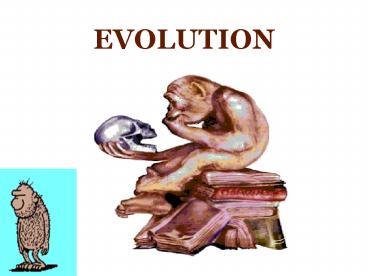EVOLUTION - PowerPoint PPT Presentation
1 / 31
Title:
EVOLUTION
Description:
evolution chapter 15 – PowerPoint PPT presentation
Number of Views:89
Avg rating:3.0/5.0
Title: EVOLUTION
1
EVOLUTION
CHAPTER 15
2
- Evolution the change over time of the genetic
composition of populations - Natural Selection populations of organisms can
change over the generations if individuals having
certain heritable traits leave more offspring
than others (differential reproductive success) - Evolutionary Adapations a prevalence of
inherited characteristics that enhance organisms
survival and reproduction
3
EVOLUTIONARY HISTORY
- Linnaeus - taxonomy - Lyell -
uniformitarianism - Hutton - gradualism - Darwin -
evolution - Lamarck - evolution - Mendel -
inheritance - Malthus - populations - Wallace -
evolution - Cuvier - paleontology - Count Buffon -
evolution
4
RESISTANCE TO THE THEORY OF EVOLUTION
5
RESISTANCE TO THE THEORY OF EVOLUTION
6
DARWINS INFLUENCES
- Taxonomy matured during mid-eighteenth century
- Linnaeus believed in
- He developed the binomial system of nomenclature
- System of classification for living things
- Count Buffon
- Wrote 44-volume catalog of all known plants and
animals - Suggested descent with modification
6
7
DARWINS INFLUENCES
- Lamarck First biologist to
- Propose evolution
- Link diversity with environmental adaptation
- Concluded more complex organisms are descended
from less complex organisms SIMPLE TO COMPLEX - Proposed inheritance of acquired characteristics
Lamarckianism
8
Passing on Acquired Traits
9
DESIRE TO CHANGE
10
Use and Disuse
11
HMS BEAGLE VOYAGE
- Invited to travel around the world
- 1831-1836 (22 years old!)
- makes many observations of nature
- main mission of the Beagle was to chart South
American coastline
12
- While on the voyage of the HMS Beagle in the
1830s, Charles Darwin observed
- similarities between living and fossil organisms
- the diversity of life on the Galápagos Islands,
such as blue-footed boobies and giant tortoises
Figure 13.1A
13
FINCHES
13
14
DARWINS INFLUENCES
MALTHUSOverpopulation and species control
LYELL Earth is subject to slow but continuous
cycles of erosion Proposed uniformitarianism,
rates and processes of change are constant
15
- Darwin became convinced that the Earth was old
and continually changing
- He concluded that living things also change, or
evolve over generations - He also stated that living species descended from
earlier life-forms descent with modification
(originally Buffon and Erasmus Darwin) - All organisms are related through decent from an
ancestor that lived in the remote past.
16
DARWINS 5 MAJOR CONCLUSIONS
1. Population has Variation 2. Variations may be
favorable 3. More offspring are produced than
survive 4. Survivors have favorable traits 5.
Populations change over time
17
ON THE ORIGIN OF SPECIES
- ......ALL THIS LEADS TO HIS THEORY OF NATURAL
SELECTION and SURVIVAL OF THE FITTEST - 1859 Publication
- Wallace influence
18
WITNESSING NATURAL SELECTION
Early 19th century Industrial Revolution
19
(No Transcript)
20
Evolution evidence Fossils
21
- The fossil record shows that organisms have
appeared in a historical sequence
- Many fossils link early extinct species with
species living today - These fossilized hind leg bones link living
whales with their land-dwelling ancestors
Figure 13.2G, H
22
2006 Fossil Discovery of Early Tetrapod
- Tiktaalik
- missing link from sea to land animals
23
Evolution evidence Homologous Structures
- Similar structure
- Similar development
- Different functions
- Evidence of close evolutionary relationship
- recent common ancestor
24
Homologous structures
spines
leaves
succulent leaves
tendrils
needles
colored leaves
25
Evolution evidence Analogous Structures
- Separate evolution of structures
- similar functions
- similar external form
- different internal structure development
- different origin
- no evolutionary relationship
26
Evolution evidence Comparative Embryology
27
Evolution evidence Vestigial Structures
- Modern animals may have structures that serve
little or no function - remnants of structures that were functional in
ancestral species - deleterious mutations accumulate in genes for
non-critical structures without reducing fitness - snakes whales remains of pelvis leg bones
of walking ancestors - eyes on blind cave fish
- human tail bone
28
Evolution evidence Molecular Biology
- Similarities in DNA, proteins, genes, and gene
products - Common genetic code
- Closely related species have sequences that are
more similar than distantly related species - DNA proteins are a molecular record of
evolutionary relationships
29
Evolution evidence Biogeography
Fig. 22-20
- Darwins observations of biogeography, the
geographic distribution of species, formed an
important part of his theory of evolution - Islands have many endemic species that are often
closely related to species on the mainland
30
NATURAL SELECTION IN ACTION
- Insecticide drug resistance
- insecticide didnt kill all individuals
- resistant survivors reproduce
- resistance is inherited
- insecticide becomes less less effective
31
ARTIFICIAL SELECTION
- Artificial breeding can use variations in
populations to create vastly different breeds
varieties
descendants of wild mustard
descendants of the wolf































